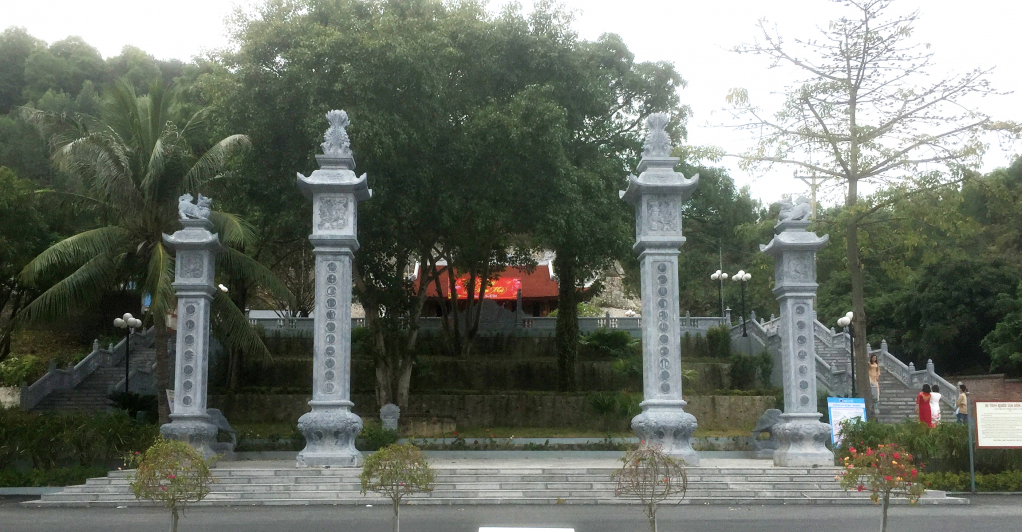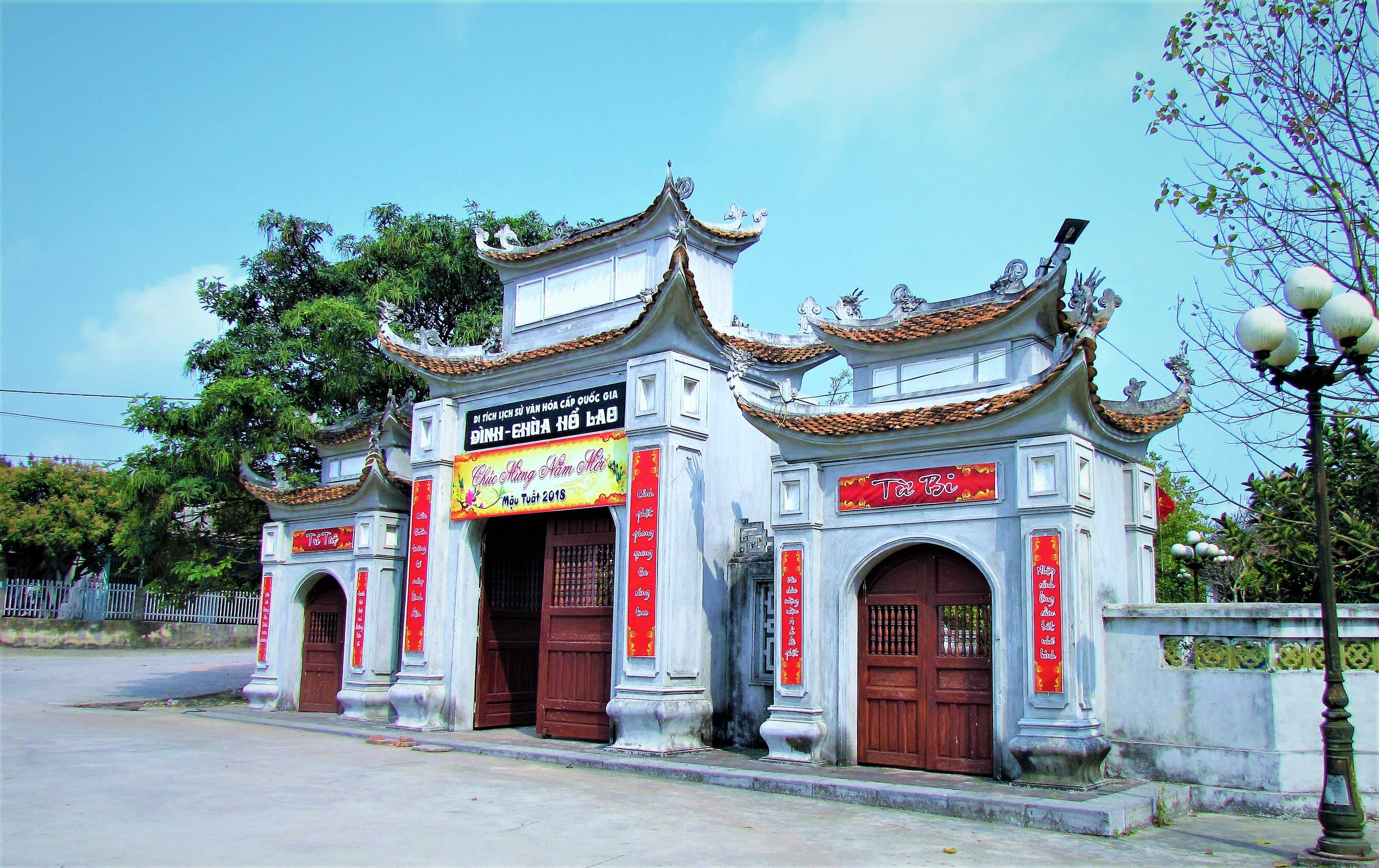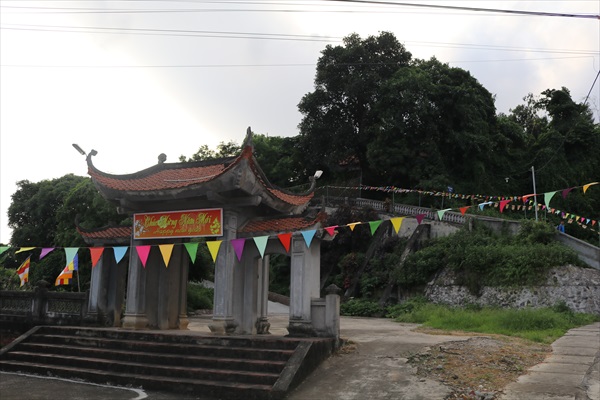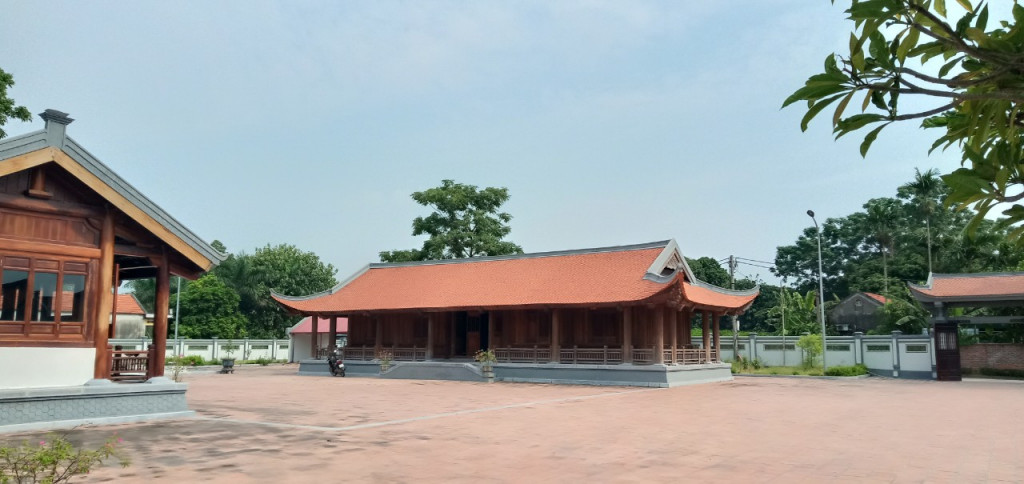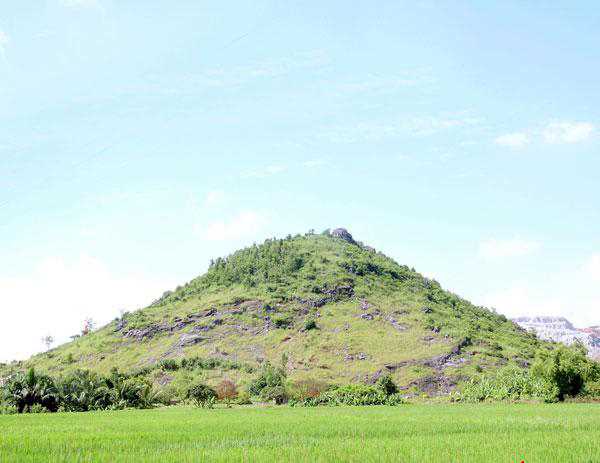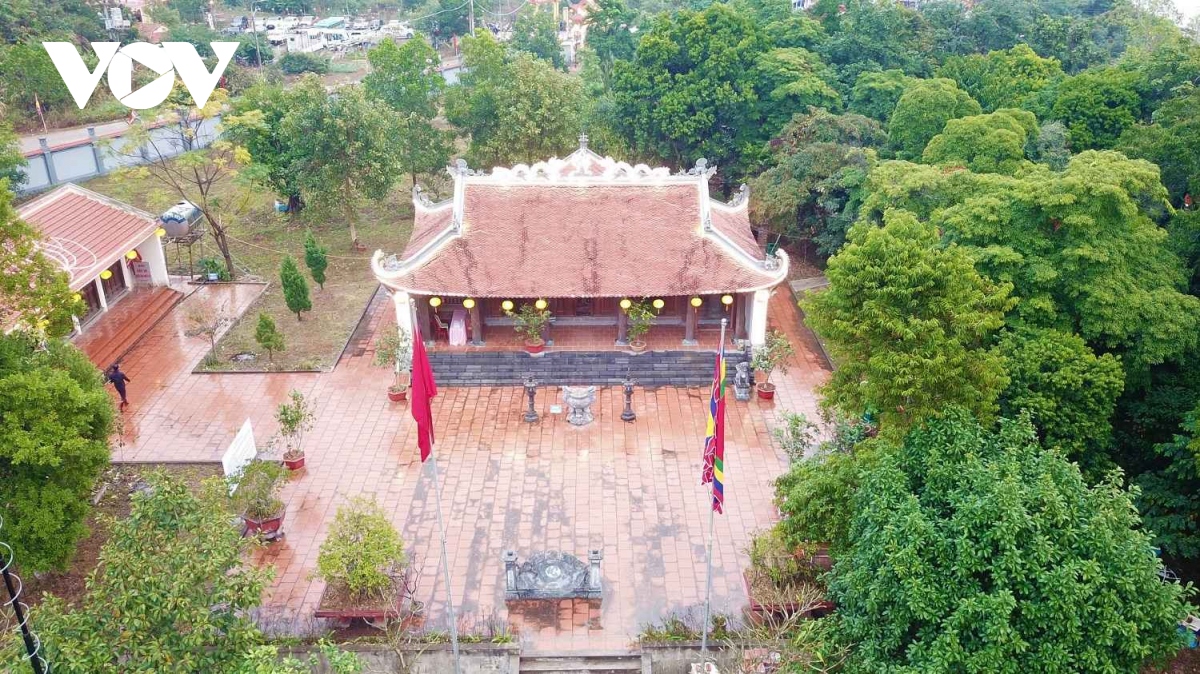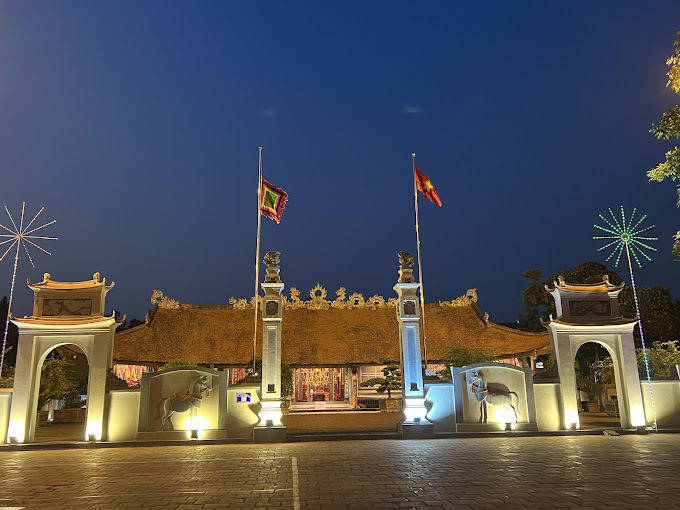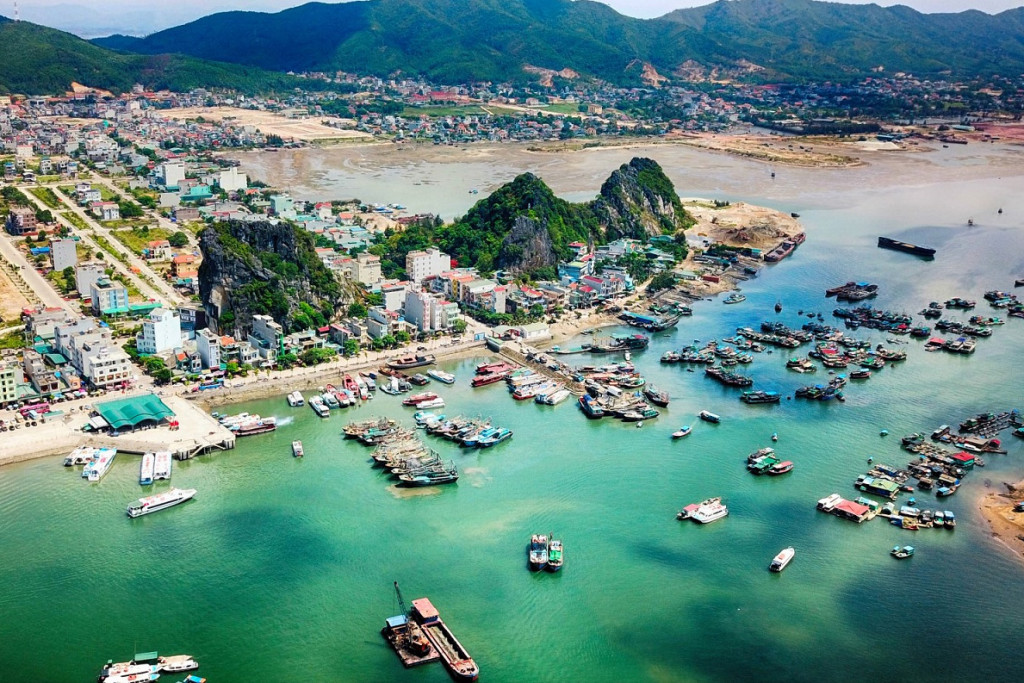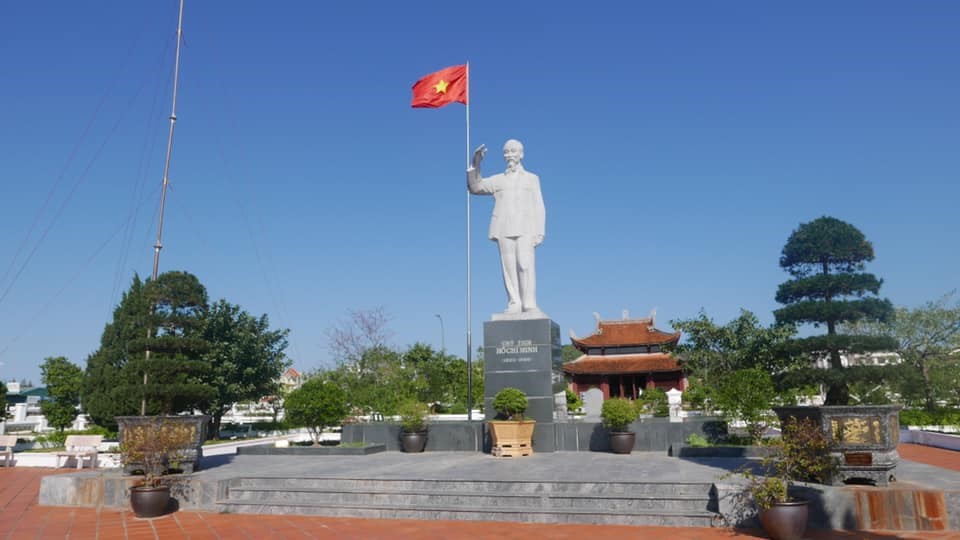Relic point Vietnam
Việt NamCao Dong Trieu Fort Relics
Cao Dong Trieu Fort is located on a hill with an altitude of 61m, with a total area of over 145,000 m2. This is a base built by the French colonialists to house the command center of the French colonial regime for Dong Trieu in particular during the period of French colonial rule. Along with Ho Lao Communal House and Bac Ma Pagoda, Don Cao is one of the places associated with the formation and birth of Tran Hung Dao War Zone - Dong Trieu War Zone. National historical relic Cao Dong Trieu Fort is located on a hill with an altitude of 61m, with a total area of over 145,000 m2. This is a base built by the French colonialists to house the command center of the French colonial regime for Dong Trieu in particular during the period of French colonial rule. This place has also entered the history of the Party Committee, government and people of Dong Trieu town's ethnic groups. Cao Dong Trieu Fort relic is the highest position in the center of Dong Trieu ward. Fort Cao is located on the main traffic route from Chi Linh, Hai Duong to Uong Bi Quang Ninh, from Kinh Mon, Hai Duong via Trieu ferry to Dong Trieu. From Dong Trieu Cao Station, it is possible to remotely observe and detect targets from the North to the South and from the East to the West of the town. Therefore, after invading Vietnam, in 1896 the French colonialists organized the construction of a military camp here to serve the war of invasion and exploit mineral resources in Dong Trieu. In 1945, our people seized power, Cao Dong Trieu station came under the management of the revolutionary government. On the morning of June 8, 1945, Cao Dong Trieu Fort was captured by the Fourth War Zone insurgents under the command of Lieutenant General Nguyen Binh, opening the August revolutionary climax in the entire region. The insurgents started from Bac Ma Pagoda, after capturing Cao Dong Trieu Fort, gathered at Ho Lao communal house. Here, on behalf of the Central Committee, Lieutenant General Nguyen Binh announced the establishment of the Tran Hung Dao resistance war zone, also known as the Fourth War Zone. In 1947, the French colonialists continuously launched major battles to retake Dong Trieu. This time, wherever they occupy, they immediately build and reinforce a system of watchtower posts and towers, aiming for long-term occupation and controlling our forces to fight back from afar. By May 7, 1954, the Dien Bien Phu campaign was completely victorious and Don Cao was under our control. Over a long period of time, many of the buildings belonging to the Dong Trieu Cao Fort relic site have been destroyed, leaving only a part of the buildings remaining such as the Ba mandarin's house, the green loincloth soldier's house and the house solitary confinement and torture of Communist prisoners, artillery barrages, blockhouse systems, underground bunkers... The vestiges here are still important evidence marking an unforgettable historical period of the entire nation in general, of Party committee and people of Dong Trieu in particular. On May 24, 2017, Don Cao relic was decided to rank as a national historical relic by the Ministry of Culture, Sports and Tourism. In the future, Don Cao will be repaired and restored. Source Quang Ninh province electronic information portal.
Quang Ninh 3152 view
Le Chan Temple (An Bien Temple)
The temple worshiping female general Le Chan (An Bien temple) is located on the slopes of Ven mountain in ancient Ven village, An Bien village, Thuy An commune, Dong Trieu town. This is where female general Le Chan was born and grew up during her childhood years with her parents. When she passed away, the people remembered her great contributions and built a temple right in her homeland to worship Mrs. Le Chan, a beautiful and talented female general who led the people to stand up and fight the enemy during the resistance. fight against Northern domination under the Trung Sisters. From a brave general fighting the enemy, female general Le Chan became a Holy Mother in the sense of folk beliefs, a special cultural phenomenon. When Le Chan passed away, her temples were established in many places in provinces such as Quang Ninh, Ha Nam, Hai Phong, Hanoi... In 2006, An Bien temple was ranked as a provincial-level historical and cultural relic. In 2017, it was ranked as a National Historical Monument. In 2018, on the occasion of the victory anniversary of Female General Le Chan (August 15 of the lunar calendar), Dong Trieu Town held a groundbreaking ceremony and started construction of the main temple. After nearly 3 years of repairing and embellishing the monument, in early 2021, the main temple, ritual gate and spacious temple yard were completed as they are today. The festival takes place for 3 days, from March 16 to 18 every year. Source Quang Ninh province electronic information portal.
Quang Ninh 3011 view
Historical relic of Ho Lao Pagoda
The village communal house - Ho Lao village pagoda was formerly located in Ho Lao commune, Dong Trieu district, Me Son district, Kinh Mon district (now Ho Lao village, Tan Viet commune, Dong Trieu town) and has existed for a long time. The communal house and pagoda are located on a relatively flat mound at the beginning of Ho Lao village. According to feng shui, that mound has the shape of a Tiger, the communal house and pagoda are built on top of this animal in the Southeast direction, in front there are lush green rice fields, in the distance there is the Dam River, behind there is a mountain range. The mountain belongs to the Dong Trieu arc. Truly a spiritual place. According to local elders, in the past, Ho Lao communal house had a Nhi-shaped architecture, the altar had five rooms, two left, the harem had three rooms, two left, the communal house was roofed with Dragon scale tiles, the beams were all made of wood. The pagoda yard is bright, clean and beautiful. The pagoda garden has many ancient trees that are green all year round, creating a peaceful and ancient look. Through many ups and downs in history, natural disasters and invaders, the communal house and pagoda of Ho Lao village were ruined, the stele was destroyed, and during the Nguyen dynasty it was restored. Currently, there are six stone steles built in the following years: Tu Duc's 17th year (1864), Thanh Thai's 16th year (1904), Bao Dai's 1st year (1926), Bao Dai's 7th year (1932), Bao Dai's 14th year. (1939) and the year of Bao Dai Nguyen. Based on the inscriptions, in 1864, the village chief, Nguyen Van Nang, and his wife, Nguyen Thi Tham, gave money to the people to repair the communal house and donated 18 acres of rice fields to the village for rotational cultivation to spend on death anniversary offerings. sacrifice. During Thanh Thai's reign (1889 - 1907), due to fire and fighting, the village communal house was again ruined, the people were scattered, and the land was abandoned. During the reign of King Duy Tan, there was a village chief, Mac Van Cuu, who wholeheartedly cared for the people, and together with Thai Trong Luong, the village leader, held a meeting with the villagers to discuss repairing the communal house. With the help of money from the white clay contractor, the villagers were able to build more pagodas and sculpt the Nine Dragon Saint Statue to worship in the pagoda. Chief Mac Van Cuu is a person who is wholeheartedly devoted to the villagers. He has spent many years working hard and suffering "finding land to recruit people, reclaiming the land, the people are peaceful, customs are good, people's meetings are established, everything is new; Don't hesitate to donate your wealth, and shape our people from that time on" (stela of Tu Duc period). From then until after the August Revolution of 1945, Ho Lao village communal houses and pagodas became the cultural centers of the village and commune. When the Viet Minh movement in Dong Trieu flourished, this place became an operating base for the revolutionary army, and many important political events took place here. On the afternoon of April 20, 1945, the first armed propaganda team of the Viet Minh Front in Dong Trieu was established. On the morning of May 1, 1945, the team held an launching ceremony in front of the Earth God Temple at Mr. Mac Van Niet's house in Ho village. TB. The team was raised by the people of Ho Lao village. Mr. Mac Van Niet and Mac Van Que were in charge of logistics for the team. In mid-May 1945, the centralized armed forces of Dong Trieu district were established and regularly practiced at Ho Lao communal house, held propaganda meetings, and conveyed instructions and resolutions of superiors. This young armed force has grown rapidly to become a solid support for the people, creating favorable conditions for the armed forces and the people to simultaneously rebel and capture 4 posts: Dong Trieu, Chi Linh, Mao. Khe, Trang Bach on June 8, 1945 and won a resounding victory. On the afternoon of June 8, 1945, in the atmosphere of the insurgents celebrating their victory at Ho Lao communal house, the uprising's leadership met and decided to establish the Revolutionary Military Committee consisting of comrades Nguyen Binh, Hai Thanh, Tran Cung and a number of other members headed by Nguyen Binh. On the morning of June 9, 1945, during a rally at the communal house of Ho Lao village, Tran Cung, on behalf of the uprising leadership, announced the establishment of a revolutionary war zone named FOURTH WAR ZONE, the armed forces of the war zone named "GUERARIAN REVOLUTIONARY ARMY", announced the list of UBQSCM. Nguyen Binh, representative of the Committee of the People's Liberation Army, announced the "seven rules of discipline of the revolutionary guerrilla army". Ho Lao has become the center of the military base of the war zone. From here, Nguyen Binh and the war zone leadership commanded units to expand their scope of operations and won many resounding victories in Uong Bi, Quang Yen, and the Northeast region of the country. The Fourth War Zone (Dong Trieu war zone - Tran Hung Dao war zone)) became a heroic anti-Japanese base in the pre-uprising period, encouraging the people of the Northeast to stand up against the Japanese, along with the whole country. leading to the victory of the General Uprising on August 19, 1945. In 1947, the French colonialists returned to occupy Dong Trieu and tried to destroy revolutionary bases, including Ho Lao village. The communal house and pagoda of Ho Lao village were also destroyed and became ruins. In 1993, the people of the village contributed money to rebuild the old temple's harem as a place for religious activities. In 1997, on the foundation of the old communal house, Tan Viet commune built a memorial stele where the FOURTH WAR ZONE was founded and recognized the children of the homeland who heroically sacrificed their lives in the two resistance wars against the French, the Americans and the Americans. protect the Fatherland's borders. Due to his many contributions to building, nurturing and protecting the revolutionary army, the people of Ho Lao village were awarded the certificate of Meritorious Service to the Country by the state. On July 12, 2001, the Ministry of Culture and Information issued a decision to recognize Ho Lao Communal House - Pagoda as a National Historical and Cultural Monument. On December 12, 2007, the Ministry of Culture, Sports and Tourism and related sectors of the province, district and locality held a groundbreaking ceremony to restore the communal house and Ho Lao pagoda and build a number of suitable works. support with a total estimated cost of nearly 16 billion VND. Buddhists and visitors from everywhere earned over 2 billion VND. The contributions of the people of Ho Lao village in particular and the people of Tan Viet commune in general have contributed to the victory of the people of Dong Trieu and were awarded the noble title "Heroic District of the People's Armed Forces" by the state. ”On May 28, 2010, the state awarded the title "Hero of the People's Armed Forces" to the people and armed forces of Tan Viet commune for their exceptionally outstanding achievements in the resistance war against the French. . Now, along with the anniversary of June 8 - the founding day of the Dong Trieu War Zone, every year the people of Tan Viet commune also have another big festival: Ho Lao communal house and pagoda festival held on the first day of new spring ( January 15). Located adjacent to Sinh Temple and Tran Dynasty tombs (special national relics) and with National Historical-Cultural values... communal houses, Ho Lao Pagoda will be an attractive tourist destination contributing to educating patriotic traditions and fighting foreign invaders; Economic, cultural, social and tourism development of the locality and Dong Trieu town. Source Electronic information portal of Dong Trieu town, Quang Ninh province.
Quang Ninh 3306 view
My Cu Pagoda (Sung Khanh Tu).
My Cu Pagoda, the literal name is Sung Khanh Tu. The pagoda was built in My Cu village, so the pagoda was named after the village. The name of the village comes from the legend: "Legend has it that King Tran Nhan Tong went to Yen Tu mountain to become a monk. People made delicious food for the king, so he named it My Cu" and the name Sung Khanh Tu has the meaning of promoting Buddhism. boundless, khanh means good. My Cu Pagoda is located on the side of Che Mountain (a turtle-shaped mountain), in My Cu village, Hung Dao ward, Dong Trieu town, Quang Ninh province. During the Tran Dynasty, Buddhism entered the most brilliant period of development in Vietnamese history and affected all areas of life. After King Tran Nhan Tong became a monk in Yen Tu and founded the Truc Lam Zen sect, Phap Loa, under the guidance of King Tran Nhan Tong, received the Dharma medicine and became the second patriarch of the Truc Lam Zen sect. . During Phap Loa's reign, Truc Lam's teachings had a strong appeal to Buddhist followers. From Yen Tu, Truc Lam teachings spread throughout the Northeast region. During this period, 800 large and small temples were built. My Cu Pagoda was also built during this period. The pagoda was built with the scale and architectural structure of the letter Ding. In later times, the pagoda was expanded quite spaciously, including the main pagoda, the ancestor's house, and the monk's house, forming an overall mouth-shaped architecture. The pagoda has undergone many restorations and embellishments, which are recorded in stele placed in the pagoda yard. But at the end of the Nguyen Dynasty, the pagoda was destroyed, leaving only the main pagoda with a nail-shaped (T)-style architecture with truss structure and sculpture that still retains its original state and a system of dharma statues with high artistic value. , such as statues: Amitabha, Shakyamuni statue, Quan Am Chuan De statue, Ca Diep statue, Anan statue... Wooden statues with related ages from the Tay Son and Nguyen dynasties are still preserved quite well. The statue system is meticulously and skillfully carved, each statue has a different shape and inner expression. The carvings are soft but strong and decisive. The colors and decorative patterns on each statue are imbued with national cultural identity. Besides, My Cu Pagoda also has carvings on the rafters, ends, lines, sevens... demonstrating the ingenuity and sophistication of the craftsmen who have the heart to create and restore the Buddha's place. Electronic information portal of Dong Trieu Town, Quang Ninh province.
Quang Ninh 3105 view
Center of Dong Trieu war zone (Bac Ma pagoda)
The center of this base is located at Bac Ma Pagoda, also known as Phuc Chi Tu, meaning pagoda towards happiness. Dong Trieu War Zone is the name given to the place, where the main base is located in Dong Trieu district, Quang Ninh province. Dong Trieu war zone is also known as Tran Hung Dao war zone (this is the naming of the Party Central Committee). Revolutionary historical and cultural relics of Dong Trieu war zone were the base of revolutionary leadership in the resistance war against French colonialism. The center of this base is located at Bac Ma Pagoda, also known as Phuc Chi Tu, meaning pagoda towards happiness. Dong Trieu War Zone is the name given to the place, where the main base is located in Dong Trieu district, Quang Ninh province. Dong Trieu war zone is also known as Tran Hung Dao war zone (this is the naming of the Party Central Committee). To further promote the preparation of armed uprising throughout the country, right from April 15, 1945, the Party Central Committee's Standing Committee convened a revolutionary military conference in Hiep Hoa (Bac Giang). decided to establish seven war zones throughout the country: Le Loi war zone, Hoang Hoa Tham war zone, Quang Trung war zone, Tran Hung Dao war zone, Phan Dinh Phung war zone, Trung Trac war zone, Nguyen war zone Tri Phuong. Implementing the decision of the Northern Military Conference, the Northern Party Committee has proposed the policy of building the Tran Hung Dao war zone in the Northeast region. During the preparation process for the uprising, the pagodas in Dong Trieu played a quite important role, Bac Ma Pagoda was the pagoda that played the most role in forming the base of the Tran Hung Dao war zone, where Master Vo Giac Thuyen regularly welcomed revolutionary monks, who were revolutionary cadres bearing the name of monks to facilitate their activities (before August 1945, Bac Ma Pagoda was a large, prestigious pagoda in the region and located In places with revolutionary traditions, these are favorable conditions for building bases). Bac Ma Pagoda is a large-scale architectural space built on a campus with an area of up to three acres of land. According to the preserved epitaphs and Chinese writings, the history of Bac Ma pagoda is over six hundred years and has been restored and embellished many times during the Le and Nguyen dynasties. Especially in the year of Bao Dai Nguyen, 1926, the pagoda was rebuilt on a larger scale, becoming a large, beautiful, and sacred pagoda. The pagoda's land has up to 20 acres with three plowing buffaloes and two helpers. Up to now, Bac Ma pagoda is no longer intact as before, the architectural frame structure has been completely ruined but some artifacts are still retained. The art of stone carving at Bac Ma Pagoda is expressed quite sophisticatedly in the remaining artifacts (steles, dragons, towers...) It skillfully combines the art of the Tran and Late Le periods. , Nguyen. The stone carving shows the sculpture of the Tran Dynasty through the dragon statue placed on the stairs, remaining. The dragon's layout is compact, the lines are very vivid and strong, the body is round, plump, gradually chubby towards the back of the tail, with slight curves. Stone sculpture of the Later Le period is clearly shown in the stone steles with the image of two dragons flanking the monstrance, coherent carvings, and soft flowers and leaves on both sides along the stele's body, stylized to represent the sculpture of the time. Pear The historical site of the center of the Dong Trieu war zone has been ranked as a National Historical Relic by the Ministry of Culture and Information according to Decision No. 2379/QD-BT, dated September 5, 1994. Source Quang Ninh province electronic information portal.
Quang Ninh 3194 view
Cluster of historical relics and landscapes in Yen Duc
Yen Duc historical and scenic relics cluster is located in the southwest of Yen Duc commune, southeast of Dong Trieu town, and west of Quang Ninh province; About 60km from Ha Long city and 100km from Hanoi capital. This cluster of relics is made up of 5 relics: Canh Mountain, Dong Thoi Mountain, Thung Mountain, Con Mouse Mountain, and Con Meo Mountain. Everything seems to converge here to form a charming mountainous area, each relic has its own historical, revolutionary, cultural value, not only has the value of beautiful scenery but is associated with each relic. is a folk legend that is closely related to each other as if inseparable. 1. Canh Mountain Relics: The mountains of Yen Khanh village and Don Son village are shaped like a plow, forming a wall blocking the northeastern gateway of the commune. During the struggle to build and maintain the country, standing on the top of Canh Mountain can cover the entire surrounding area, guard stations on the mountain were built, so Canh Mountain also means Watch. At Canh Mountain, long ago Tran Nhan Tong chose this place to command the 2nd long-range battle of Bach Dang Giang (1285). The period of fighting the Northern invaders in Yen Duc was also associated with the nation's process of building and defending the country. During the resistance war against the French, Canh Mountain was once the resistance base of the Yen The insurgent army, and was a food reserve to serve the resistance. Also from this campaign, the nooks and crannies and caves on Canh Mountain were opened up with names that will live forever in the country such as: Bong Root Cave, Gao Root Cave, Luon Cave... Cave 73 on the west side of the mountain - where it is recorded. marks the heinous crimes of the French colonialists who killed and burned 106 people, including 73 soldiers, officers, and our compatriots sharing one grave. Each cave is associated with glorious victories, going down in history with great victories in the hearts of Yen Duc people. 2. Dong Thoi mountain relic: Located in the heart of Yen Duc mountain complex, one side is Thung mountain, the other side is Con Meo mountain. The mountain is shaped like a pile of rice, both large and full. For agricultural residents, it is a symbol of prosperity, abundance, affluence, and richness of Vietnamese villages. 3. Con Mouse Mountain Relics: Located last to the south in a cluster of relics on a floating beach between the confluence of Da Bach River, Kinh Thay River, and Da Vach River, the shape resembles a rat stalking rice, but is blocked by Con Meo Mountain. In the legend of Mouse Mountain, the symbol of evil forces in both the broad and narrow sense. Destroying human achievements. 4. Con Meo Mountain Relics: Also known as Ngoa Mieu Son, its shape resembles a cat lying in wait for mice, blocking mice to protect the pile of rice and protect human achievements. And it is also a symbol of protection for the peace, prosperity and longevity of the country. This is also the location for commanding the long-range battle of Bach Dang Giang against the second Mongol invasion (1285). The relic is listed as one of the famous mountains of the Northeast region. In the cave dome, there are a number of poems written in Nom, Chinese, and Quoc Ngu, including a famous Nom poem with the words "The Emperor's Humanity reigns. The era name is restored to eight years of spring". However, now only the dome of the mountain cave remains, and the cat's body and head have been destroyed. 5. Thung Mountain Relics: Located to the west of the relic complex. Thung means rice mortar, at the foot of the mountain is a surrounding stone wall. In the past, on the east side of the mountain, there was Canh Huong Pagoda, which was restored in 1694, but in 1980 - 1982, the pagoda was completely destroyed, leaving only a poem carved into the rock and a stele carved in the rock crevice of the mountain. Thung, in 1994 - 1995 the pagoda was restored. On the east side of the mountain there is a three-story tower, and on the south side there is a gate called Thung gate, two floors built of red bricks. In the south of the foot of the mountain there is a One-roof Pagoda. There is a large stone slab forming a cave entrance where people set up an altar. Outside, a wall was built to expand in front of the door. Inside there are also a number of statues, especially noteworthy is the only remaining one. At least one gilded red book with four embossed Chinese characters: Thi Ung Xuong Ky; On the left side of the One-roof Pagoda is a temple worshiping the 8 ancestors who publicly founded the village, which was repaired in 1987. On the right side of the pagoda is a freshwater well, with a poem written in Chinese characters carved into the cliff telling about the event of the year of drought. The Han dug this well, the poem is engraved with the era name: Khai Dinh, three years and three moons, next to the well is a poetry jar building built in the 19th century on a rock floating to the southwest of the mountain, with 4-door arched architecture. In fact, there are two poems written in Chinese ink in a book on the upstairs wall. Thung mountain relic is not only a scenic spot and a name associated with the subconscious of wet rice farming residents, but also a place to mark historical and cultural events, preserving many Chinese epitaphs that went through the construction process. and retain water. With historical, revolutionary, cultural and scenic values, the Yen Duc relic cluster has been ranked by the Ministry of Culture and Information as a national historical and scenic site. Source Quang Ninh province electronic information portal.
Quang Ninh 1972 view
National historical relic Ong Temple - Ba Temple
National historical relics of Ong Temple and Ba Temple in Nam Son commune, located on opposite sides of the Ba Che river, reflecting in the clear blue water, charming landscape, about 1km from Ba Che bridge. Every year, on March 1 of the lunar calendar, Nam Son commune, Ba Che district organizes the Ong Temple - Ba Temple Festival. The Ong Temple - Ba Temple relic is located in Nam Son commune, nearly 1 km from Ba Che bridge. Ong Temple is the place to worship the village's Tutelary God: God Tam Tri and national heroes. According to preserved research documents, Ong Temple worships Saint Phu Tran left general Le Ba Duc, who had great contributions in joining the Tran Dynasty's army and people to fight the Nguyen - Mongol invaders in the 13th century. In February 1285, in a strategic operation to create position and force against the Yuan-Mongol army, Thai Thuong Hoang Tran Thanh Tong, King Tran Nhan Tong and National Cong Tran Quoc Tuan crossed the Ba Che River. Accompanying the household was General Le Ba Duc. He was not only a good military leader, but also made the right decisions. Realizing the strength of the enemy army, the left general had the king's guardian and Thai Thuong Hoang leave the boat and walk to Thuy Chu to continue the journey to Thanh Hoa. During a close fight with the enemy, General Le Ba Duc died. Impressed by his sacrifice for the country and the people, the local people built a temple to worship him and declared him the village's god emperor. With great historical, cultural and spiritual values, in 2013 the Ong Temple - Ba Temple relic was ranked as a provincial historical relic, and in October 2020 it was recognized as a level historical relic. Nation. Right next to the Ba Che river, opposite the Ong Temple is the Ba Temple. This is the place to worship Mother Goddess Thuong Ngan (ie Queen of the green forest). According to legend, Mau is the daughter of Son Tinh (ie Tan Vien Son Thanh) and Princess My Nuong (daughter of the 18th Hung King). She was instrumental in teaching mountain people how to grow fruit trees, grow upland rice, build terraced fields, build houses, pick medicinal plants to treat diseases... In July 2014, she received the attention of the Church's Executive Board. Vietnamese Buddhism in Quang Ninh province provided financial support and support from many organizations and individuals inside and outside the district, the entire construction of Ba Temple was completed and opened to serve the spiritual needs of the people. ethnic groups in the district and tourists from near and far. Source Quang Ninh province electronic information portal.
Quang Ninh 2409 view
Tra Co communal house
Tra Co communal house is located in Nam Tho area, Tra Co ward, Mong Cai city, Quang Ninh province, Vietnam. This is considered a rather massive communal house in the top part of the country and completely bears the mark of Vietnamese culture. According to the scientific ranking profile of the relic, the Communal House was built in the Later Le Dynasty (1461), the formation and existence of Tra Co communal house is closely linked to the history of formation and development of Tra Co land. Nowadays. According to legend, in the Later Le Dynasty (1461), people working as fishermen from Do Son land (belonging to Hai Phong city today) often went as a family to earn a living in many remote sea areas, all over the region. estuary (Belonging to the current Tra Co - Mong Cai sea area). During a big storm, twelve families drifted onto a deserted peninsula with only tiger parrots and reeds. Unable to bear the hardship, six families found a way to return to their hometown. The remaining six families are determined to cling to the land and build a new countryside. Then, every day they explored new land together, fishing and reclaiming land. Initially there were only 6 simple houses and gradually became a prosperous village. And like many other villages in Vietnam, Tra Co communal house was built with contributions from the people. After building the communal house, local people returned to their old hometown to ask for the feet of the village tutelary gods to worship at the communal house (Khong Lo, Giac Hai, Nhan Minh, Huyen Quoc, Quang Trach). In addition, this is also the place of worship for the six pioneers who made public declarations and established the ancient Tra Co land. Experiencing the effects of time, up to now Tra Co communal house has undergone many major restorations. The most recent restoration was in 2012. The current communal house, built on a plot of land with a total area of more than 1000 m2, facing south, has a nail-shaped architecture, including 05 rooms and 02 walls. worship hall and 03 harem rooms with traditional wooden architectural structure. The entire structure is constructed using a wooden frame and linked together by mortise dowels. The communal house is a majestic ancient structure, with a tiled roof and four curved corners like a boat moving through the waves, creating an elegant appearance. In particular, the truss panels show strong, sophisticated and vivid carvings. Rich themes include engravings of dragons swirling in water and phoenixes flying, tigers stalking prey among flowers and leaves... Each engraving is a unique work of art with a contemporary imprint. This is considered one of the communal houses with massive scale and unique architecture in the Northern Delta region. Currently, at Tra Co communal house, many valuable artifacts are still preserved such as: 03 bronze incense burners, 2 cranes riding turtle heads made of wood lacquered with gold, 8 wooden thrones of the Nguyen Dynasty, 12 ordinations. paper material… Every year, from May 30 to June 3 of the lunar calendar, many traditional festival activities take place at Tra Co communal house. This is a large-scale festival, typical of the type of folk festival in Mong Cai city in particular and the country in general. The unique features of Tra Co communal house festival are the procession of gods on the sea and the "Mr. Elephant" contest (A contest between 12 pigs that are cared for and raised by 12 men). Source Quang Ninh province electronic information portal.
Quang Ninh 2196 view
Van Don commercial port relic
Established in 1149, Van Don became the first trading port of Dai Viet. Trang Van Don becomes the last administrative unit in the local administrative system. To protect national security, the royal court stipulated that foreign ships, whether far or near, entering the port must anchor in Van Don and not proceed further inland. Foreigners are only allowed to trade in certain locations and are subject to state control. The Ly Dynasty (1009-1225) introduced many policies to encourage foreign trade, so trade in Van Don developed. Goods exported by foreign ships are mainly agarwood, pearls, ivory, cinnamon bark, rhino horn, gold, silver, copper, saltpeter, sea seafood... Imported foreign goods are brocade. Only the state is responsible for foreign trade activities, private individuals are not involved. During the Tran Dynasty (1225-1400), the world spice market was vibrant, and the invention of the maritime route across the sea from China to Egypt pushed the pace of international trade to grow stronger. Trade at Van Don commercial port is bustling, expanding with many countries such as Japan, Mongolia, the Philippines and Europe. The protection and management of foreign trade in the Van Don region was assigned by King Tran to princes and high-ranking mandarins. Prominent among them is King Nhan Hue Tran Khanh Du. At this time, Van Don was closely guarded. Wooden fences were erected around key shopping areas and beaches of the island. Tran Khanh Du also prevented Chinese troops from blending in by having Van Don military equipment wear Ma Loi hats, a type of hat made from Ma Loi incense, Hong Lo (now Hai Duong) to easily recognize Dai Viet troops. . Because most Van Don people work as traders, their way of dressing is similar to that of Northerners. Complete History of Dai Viet records: "Many merchant ships that previously entered Tha and Vien estuaries in Chau Dien, now mostly gather in Van Don." Not only expanding in administrative boundaries, Van Don was raised from a village to a town, established in the reign of Tran Du Tong (1345), on Hai Dong road, later changed to An Bang road. The Tran Dynasty placed the mandarin in charge of Van Don as a major town, including the Tran mandarin (martial general), the Lo mandarin (literary mandarin) and the sea envoy (sea surface control officer), placing an army here. specifically called Binh Hai military, has the task of patrolling and protecting the Northeast coast, controlling the security of foreign trade activities. In addition to trading, the Tran kings also built many large-scale pagodas and towers such as Lam pagoda, Trong pagoda, Cat pagoda, Bao Thap... in Thang Loi commune to meet the religious needs of residents and foreign traders. besides worshiping Buddhism. The early Le Dynasty (1428-1527) after gaining independence implemented many strict policies on foreign trade. The court very clearly regulated activities at Van Don trading port in the National Trieu Penal Code (often called Hong Duc Law). Accordingly, the officials who went to Van Don without permission were either treated as criminals or exiled; The person who reports the matter is entitled to privacy (Article 612). Article 615 of Hong Duc Law clearly states: "A person at Van Don site who transports goods to the capital to sell and upon returning without a permit from the An Phu company and a survey certificate from the De Bac company will be subject to sarcasm and fined 100 francs." money; reward the accuser with one-third of the fine. If you arbitrarily bring goods to sell in villages outside the capital, you will be prosecuted and fined 200 francs. If An Phu company and De Bac company did not know it, they would be satirized in private; If you intentionally tolerate it, you'll be satirized and dismissed." Foreign boats that want to come to Van Don site to do business and stay for a long time must submit a document to the An Phu company. If the site owner does not present it and arbitrarily allows them to stay, they will be fined 200 francs. Due to strict control, commercial activities in Van Don declined compared to the Ly and Tran dynasties but still occupied an important position under the Le dynasties. During the Mac Dynasty (1527-1677), with the open trade policy, foreign trade activities at Van Don trading port flourished again. The Mac Dynasty also built a pagoda in Vung district, Thang Loi commune, and built citadels in Cam Pha and Hoanh Bo to defend the country. During the Renaissance of the Le Dynasty (1533-1789), trading activities in Van Don were still developed. In addition to trading, the Le Dynasty also paid attention to building village communal houses to serve as a place for spiritual and cultural activities for island residents such as Cai Lang communal house, Cong Cai communal house, Quan Lan commune. At the end of the 17th century, Ke Cho (Thang Long), Pho Hien (Hung Yen), Hoi An (Quang Nam) opened their doors for Chinese, Japanese, Dutch, British... merchant ships to go deep inland to trade. Van Don trading port completely lost its role as a commercial center. Foreign trade activities still take place, but are no longer busy. Entering the early 19th century under the Nguyen Dynasty, Van Don trading port was no longer active. Residents on some ancient wharves moved to other places, and wharf warehouses were gradually damaged. Commercial boat wharves were converted into wharfs to serve the needs of local people for fishing and exchanging forest and seafood products to other places in the country. Over time and the sedimentation of the sea, the bustling appearance of the old Van Don commercial port no longer exists. Currently, in the ground on the banks of ancient wharves, there are still millions of broken or intact pieces of porcelain, house floors, communal house floors, pagoda floors, and ancient bronze coins spanning 7 centuries. Van Don is the first commercial port of Dai Viet country, not only operating on a single line with only one port but also a system of interconnected yards and docks. The center of the commercial port is 200km2 in area, in Bai Tu Long Bay, in Thang Loi, Quan Lan, Minh Chau, Ngoc Vung communes, Van Don district. Cong Dong - Cong Tay area (Thang Loi island commune, Van Don district) was once the center of Van Don trading port. For nearly 7 centuries, Van Don commercial port was crowded with merchant ships from China, Japan, Mongolia, the Philippines and Europe. Goods exported by foreign ships are mainly agarwood, pearls, ivory, cinnamon bark, rhino horn, gold, silver, copper, saltpeter, seafood... Imported foreign goods are brocade. . Over time and the sedimentation of the sea, the bustling appearance of the old Van Don trading port no longer exists. Currently, underground and on the banks of ancient boat wharves, there are still millions of pieces of porcelain, house floors, communal house floors, pagoda floors, and ancient bronze coins. With historical values, Van Don commercial port was granted a historical relic status by the Ministry of Culture and Information (now the Ministry of Culture, Sports and Tourism) on October 29, 2003. On October 24, 2023, the Prime Minister issued Decision No. 1225/QD-TTg on the classification of the Van Don Commercial Port Complex Historical Monument as a special National Monument. Source Quang Ninh province electronic information portal.
Quang Ninh 2472 view
Memorial area of President Ho Chi Minh on Co To island
Special National Relic of President Ho Chi Minh's Memorial Site on Co To Island was previously named "Historic Monument of President Ho Chi Minh's Memorial Places on Co To Island", and people often call it affectionately. is Uncle Ho's relic. This is a special relic, with its own value, not overlapping with any relic in the system of relics about President Ho Chi Minh throughout the country. The relic is located in the southwest of Co To island, now belonging to zones 1, 2, 3, Co To town. According to relic records, after President Ho Chi Minh visited the mining area and allowed Hai Ninh province (now part of Quang Ninh province) to erect a statue of Man on Co To island (January 1962), the Hai Ninh Administrative Committee decided to erect a statue of Uncle Ho and build a memorial area for President Ho Chi Minh on Co To island to commemorate the event of Uncle Ho's visit to Co To island on May 9, 1961. This relic area includes 5 relics: President Ho Chi Minh statue relic site, temple relic site, Doc Khoai relic site, souvenir exhibition house relic site and salt field relic site. The first statue of President Ho Chi Minh on Co To Island was a cement bust, built and inaugurated in 1968. In 1976, the bust was replaced by a full-body statue, made of reinforced concrete. steel. In 1996, the Department of Culture and Information (now the Department of Culture and Sports) upgraded the statue of President Ho Chi Minh on Co To island on the basis of keeping the full-body statue model intact but adapting the material from concrete. reinforced steel to granite material to ensure the sustainability of the project. The project was completed on May 12, 1997. Behind the statue of President Ho Chi Minh is a stele marking the event of Uncle Ho's visit to Co To island on May 9, 1961. Uncle Ho's statue and stele marking the event were built right at the location where the helicopter carrying Uncle Ho to visit Co To landed in the past. According to history books, during his visit to Co To Island, when passing through the potato fields, President Ho Chi Minh wanted to see the yield and quality of potato varieties grown on the island, said Comrade Hoang Chinh, Secretary of the Hai Ninh Provincial Party Committee. Tried digging up a potato bush for Uncle to see. The President Ho Chi Minh Memorial Exhibition House on Co To Island is a renovated project (in the 1970s) from the former Co To Commune Administrative Committee headquarters. This is the place to display a number of artifacts about the historical periods of Co To island district, especially artifacts related to Uncle Ho. The relic has become a highlight of great political significance and has great value in many aspects in terms of landscape, culture - history and aesthetics in the northeastern sea of the country. The historical relic of President Ho Chi Minh's memorial area on Co To island is a lasting "cultural milestone", a "sovereignty milestone" of Vietnam on the island, and a precious national heritage that needs to be protected. Preserve and honor the unique historical and cultural values of the monument in association with educating the nation's traditions and history. At the same time, it is also a special asset and a driving force for Co To to change and transform, aiming to become a dynamic marine economic region, attracting investors as well as domestic and international tourists to Co To. Bowl. Uncle Ho's statue on Co To island is a work of high visual artistic value, has a very special position in the system of monuments to President Ho Chi Minh at home and abroad, is the first and beautiful statue of Uncle Ho. of the Northeast region. In addition to the value of visual arts, the monument also has the value of harmonious landscape, built on a beautiful terrain with charming feng shui, overlooking the windy, white-sand beach of Co To Bay. smooth and winding stretches. An ideal swimming beach. A sheltered parking area for boats whenever there is a storm. Over the course of more than 50 years of formation and development, the historical relic of President Ho Chi Minh Memorial Site on Co To Island has always received attention from the competent authorities and all people, investing resources for it. planning, renovation and embellishment work. Since being recognized by the Ministry of Culture and Information as a national relic until now, some items of the Historical Relic of President Ho Chi Minh Memorial Area on Co To Island have been preserved in their original state. Earlier this year, the relic was recognized by the Prime Minister as a special National Monument. Source: Quang Ninh Electronic Newspaper
Quang Ninh 2968 view

